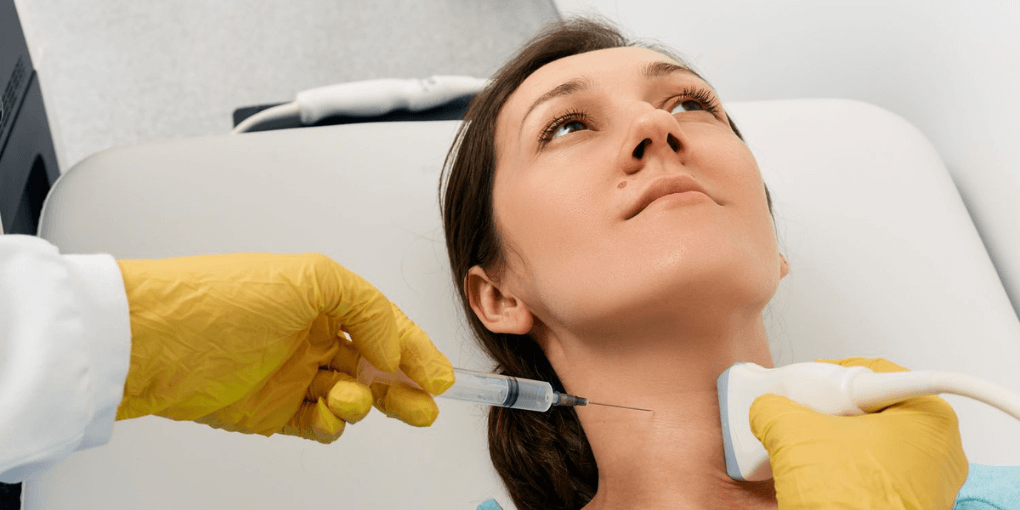Have you ever wondered about the tiny butterfly-shaped gland in your neck, called the thyroid? Well, it’s a superhero that controls how our body uses energy. But even superheroes can have troubles sometimes.
That’s where a special test comes in, known as a thyroid biopsy, which helps doctors become thyroid detectives.
In this blog, we’re going on a journey to understand this key test. We’ll find out why it’s so critical in diagnosing thyroid conditions.
Get ready, it’s time to become mini doctors ourselves and dive into the exciting world of medical science! Let’s go!
Table of Contents
ToggleThyroid Biopsy Procedure
This biopsy is commonly done using Fine Needle Aspiration (FNA). It is crucial for diagnosing thyroid conditions. Here’s a simplified guide to understanding the procedure:
- Consultation: Your doctor will explain about what they’re going to do, why it’s important, and what might happen. It’s like having a chat where you can ask anything or say if you’re worried. They’re there to help and make sure you’re comfortable.
- Preparation: Before the test, you might need to stop taking some medicines. Then, they’ll ask you to lie down and tilt your neck a bit. It’s like finding the most comfy position for a quick check.
- Local Anesthesia: They might use a special medicine to make the area around your thyroid numb. It’s like a little trick to make sure you don’t feel anything, so it’s not uncomfortable.
- Guided Needle Insertion: The doctor uses a very thin needle to go through your skin into the thyroid. They use ultrasound, a cool tool, to guide the needle right where it needs to go. It’s like making sure the superhero hits the bullseye!
- Sample Collection: The needle will collect a sample of cells from your thyroid nodule. You might feel a little push or some strange feelings, but it’s okay. It’s like a gentle reminder that the needle is doing its job. Nothing to worry about!
- Needle Withdrawal: After collecting the sample, the doctor will withdraw the needle. This process usually takes about 20-30 minutes.
- Post-Biopsy: You can expect to resume your daily activities soon after the procedure. Your doctor will give you aftercare instructions and will send the collected sample to a lab.
- Results: The samples go to a lab, and a special doctor looks at them closely with a microscope. This helps your doctor decide if the cells are okay, bad, or a bit tricky. It’s like checking with a magnifying glass to know what’s happening inside.
Thyroid Conditions Diagnosed Through Biopsy
It is a crucial tool for diagnosing various types of thyroid conditions. It not only says if something’s wrong with the thyroid but also tells if the bump is a good or bad one.
It even helps the doctor know the exact plan to make it all better. Here are some common conditions identified through a this process:
- Thyroid Nodules: Imagine little bumps in your thyroid, they’re called nodules. Most are harmless, like friendly neighbors. But to be sure, the biopsy is like a superhero checking if there are any bad cells hiding in there. It’s a bit detective story for your health!
- Thyroid Cancer: The biopsy helps find out if there’s any of these four types of thyroid cancer: papillary, follicular, medullary, and anaplastic. Each one is a different character in a story. The biopsy helps the doctor see them under a special microscope.
- Thyroiditis: Usually, they don’t need a biopsy to check for thyroiditis, which is like a grumpy thyroid. But if other tests don’t give a clear answer, the biopsy works as a backup plan. It helps when things are a bit tricky to figure out.
- Goiter: A goiter is like a big thyroid, and it can happen for different reasons. For example: lack of iodine. The biopsy is like a great tool that helps find out why the thyroid got so big.
- Hashimoto’s Disease: For this illness where the body acts a bit confused, doctors usually check with blood tests. But sometimes, they need the biopsy superhero to make sure everything’s clear.
Thyroid Biopsy Side-Effects
While this is safe, like all medical procedures, it may have some potential side effects. It’s important to be aware of these to manage your expectations and to know when to get medical help. Here are some possible side effects:
- Mild Discomfort or Pain: After the needle check, you might feel a bit uncomfortable, like a tiny ache. But don’t worry, it gets better fast. If you need, regular pain medicine can help you feel cozy again.
- Bruising and Swelling: It’s normal to experience some bruising and swelling around where the needle went. This should reduce over a few days after the procedure.
- Bleeding: Although rare, there may be slight bleeding or seepage from the needle insertion site. Your medical team will provide you with aftercare instructions on how to handle such situations.
- Infection: The needle is super clean, so the chance of getting sick is very, very low. But if you see extra redness, puffiness, or feel warm, tell your doctor right away. It’s like having a hotline to keep everything safe and sound.
- Difficulty Swallowing: After the check, swallowing might feel a bit funny for a short time. It’s a tiny pause and gets better soon. But if it hangs around, just let your doctor know. They’re there to make sure everything feels right.
Beyond Diagnosis: Treatment Implications
This biopsy is a very important test. It helps the doctor figure out how to help your thyroid. It’s like a special plan made just for you.
- Sorting Treatment: The biopsy helps the doctor know if a lump is a friendly neighbor or a tricky one. If it’s friendly, you might only need check-ups. But if it’s tricky, like cancer, the doctor might need to do more things, like surgery, to make it go away.
- Deciding Treatment: This test not only finds out if it’s cancer but also the type of the cancer. This helps the doctor choose the best way to fix it. It’s like having a special tool for each job. For some cancers, there’s even a cool treatment called radioiodine therapy.
- Checking Progress: After the treatment, they might do another biopsy to check if everything is okay or if there’s still some tricky stuff. It’s a follow-up to make sure everything stays good.
- Avoiding Extra Treatment: If the test is a bit fuzzy, they might do it again or try a different test. Doctors do double-checking to make sure you only get the right treatment. They want to be extra sure, so you don’t get any unnecessary treatment.
- Making a Personal Plan: The biopsy gives the doctor all the details. It’s a superhero map showing the kind, size, and place of the lump or cancer. With this map, the doctor plans a special treatment for you.
What are Some Common Concerns of this Biposy
Here are some common concerns regarding this test:
- Fear of Pain: The biopsy is designed to be quite gentle. It’s like a small pinch, and often, they use numbing medicine to ensure minimal discomfort.
- Worries about Bruising and Swelling: It’s normal to have a little bruise or puffiness where the needle went in. Think of it as a tiny superhero badge. The magic? It disappears on its own in just a few days.
- Infection Concerns: The needle is super clean, so getting sick is extremely rare. However, if you notice any extra redness, swelling, or warmth, it’s always good to inform your doctor.
- Swallowing Difficulty: After the check, swallowing might feel different for a short time, like a tiny pause. If it happens, your doctor is just a call away to make sure everything is on track.
- Repeat Biopsy Anxiety: Some might need a repeat biopsy, not because something is wrong, but as an extra check. It’s like ensuring the plan is foolproof for your health.
FAQ
Here are some FAQs related to this biopsy:
Q: What is a Thyroid Biopsy?
A: It is a medical test. A small sample of cells is taken from a thyroid nodule to check if it’s non-cancerous or cancerous.
Q: Why is a Thyroid Biopsy Important?
A: The biopsy helps to decide the correct treatment plan. It tells if the lump is non-cancerous. Such lumps usually just need monitoring. If it’s cancerous, it typically needs more treatment.
Q: Can I eat before the biopsy?
A: Usually, yes. But your doctor might give specific instructions, so it’s good to check with them.
Q: Can a Thyroid Biopsy Spread Cancer?
A: No, it is a safe procedure that does not cause cancer to spread.
Conclusion
So, to sum it up, a thyroid biopsy is a great tool for checking thyroid health. It’s simple, safe, and super quick.
It helps the doctor figure out exactly what’s going on with your thyroid and what’s the best way to fix it.
Taking charge of your health is super important. Don’t let misconceptions or worries stop you from getting the necessary procedures done.
If you or someone you care about has thyroid nodules, talk to your doctor about the benefits of a biopsy.
Take charge of your health and keep your thyroid health in check. As they say, knowledge is power — make sure you’re armed with the right information.





